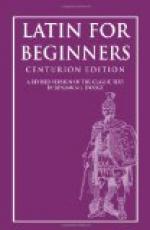[Footnote 10: vineae\. These vineae\ were wooden sheds, open in front and rear, used to protect men who were working to take a fortification. They were about eight feet high, of like width, and double that length, covered with raw hides to protect them from being set on fire, and moved on wheels or rollers.]
[Footnote 11: plutei\,
large screens or shields with small wheels
attached to them. These
were used to protect besiegers while moving
up to a city or while serving
the engines of war.]
[Footnote 12: tormenta\. The engines of war were chiefly the catapult for shooting great arrows, and the ballista, for hurling large stones. They had a range of about two thousand feet and were very effective.]
[Footnote 13: The agger\, or mound, was of chief importance in a siege. It was begun just out of reach of the missiles of the enemy, and then gradually extended towards the point to be attacked. At the same time its height gradually increased until on a level with the top of the wall, or even higher. It was made of earth and timber, and had covered galleries running through it for the use of the besiegers. Over or beside the agger a tower was moved up to the wall, often with a battering-ram (aries) in the lowest story. (See picture, p. 221.)]
[Footnote 14: perfregerunt\, from perfringo\.]
[Illustration: BALLISTA]
[Illustration: TURRES, ARIETES, VINEA]
LXXIV. THE CITY IS TAKEN : THE CAPTIVES ARE QUESTIONED
Omnibus rebus necessariis ad oppugnandum a Publio comparatis, deliberatur in concilio quod consilium [1]oppidi expugnandi ineant.[2] Tum unus[3] ex centurionibus, vir rei militaris peritissimus, “Ego suadeo,” inquit, “ut ab ea parte, ubi aditus sit[5] facillimus, aggerem exstruamus[4] et turrim promoveamus[6] atque ariete admoto simul murum discutere conemur.[5]” [6]Hoc consilium cum omnibus placeret, Caesar concilium dimisit. Deinde milites hortatus ut priores victorias memoria[7] tenerent, iussit aggerem exstrui, turrim et arietem admoveri. Neque oppidanis[8] consilium defuit. Alii ignem et omne genus telorum de muro in turrim coniecerunt, alii ingentia saxa in vineas et arietem devolverunt. Diu utrimque acerrime pugnatum est. Ne vulnerati quidem pedem rettulerunt. Tandem, [9]de tertia vigilia, Publius, quem Caesar illi operi[10] praefecerat, nuntiavit partem[11] muri ictibus arietis labefactam concidisse. Qua re audita Caesar signum dat; milites inruunt et magna cum caede hostium oppidum capiunt.
Postridie eius diei, hoc oppido expugnato, [12]captivorum qui nobilissimi sunt ad imperatorem ante praetorium[13] adducuntur. Ipse, lorica aurata et paludamento purpureo insignis, captivos per interpretem in hunc modum interrogat:[14] Vos qui estis[15]?
INTERPRES. Rogat imperator qui sitis.




